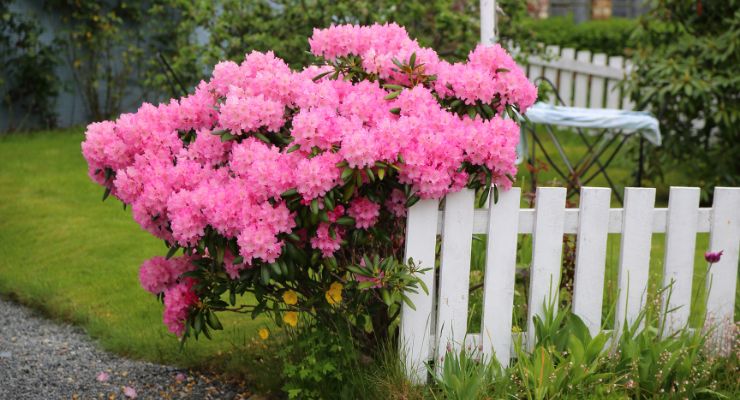Pink flowering shrubs can add a beautiful touch of color and texture to any garden or landscape. With a wide variety of species and cultivars to choose from, shrubs with pink flowers offer options for every season, from early spring to late fall.
Whether you’re looking for a compact shrub to fill a small space, or a larger shrub to create a focal point in your yard, there are pink shrubs that can fit the bill. Some species even offer additional benefits, such as attracting pollinators or producing edible fruit.
In this article, we’ll explore some of the most popular pink flowering shrubs, including their characteristics, growing requirements, and tips for caring for them. Whether you’re a seasoned gardener or just starting out, you’re sure to find inspiration for your next pink flowering shrub project.
Bird-In-A-Bush ‘George Barker’ (Corydalis solida)
Corydalis solida ‘George Baker’ is a cultivar of a delicate flowering plant species that grows from a bulb and is commonly known as fumewort, spring corydalis, or solid-tubered corydalis. This plant species is native to moist and shady habitats in northern Europe.
To maintain this low-maintenance plant, plant it in fertile and well-drained soil in full sun or partial shade. Water and feed the plant regularly and remove any weeds that may grow around it. The plant becomes dormant during the summer, and there will be no foliage or bright pink flowers at this time. The plant is advisable to propagate through division, with the best time being in the autumn. It is recommended to plant it around late-emerging perennials such as hosta.
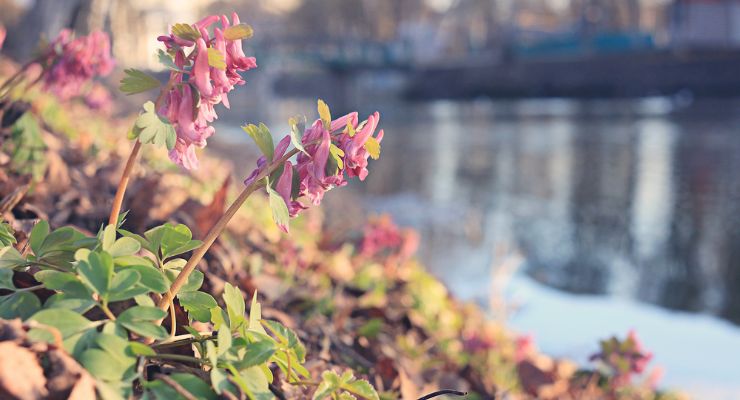
Pink Lilac (Syringa)
To ensure the pink lilac plants are healthy and vibrant, providing them with at least six hours of sunlight every day is crucial. Lilacs thrive in well-drained, fertile, humus-rich, and neutral to alkaline soil with a pH near 7.0. To prevent powdery mildew, it is best to provide good air circulation around the plants. Avoid planting them in an area with grass directly underneath, as the regular watering can be too much for them. Generally, pink lilacs are low-maintenance shrubs, and their care is minimal, except for regular pruning.
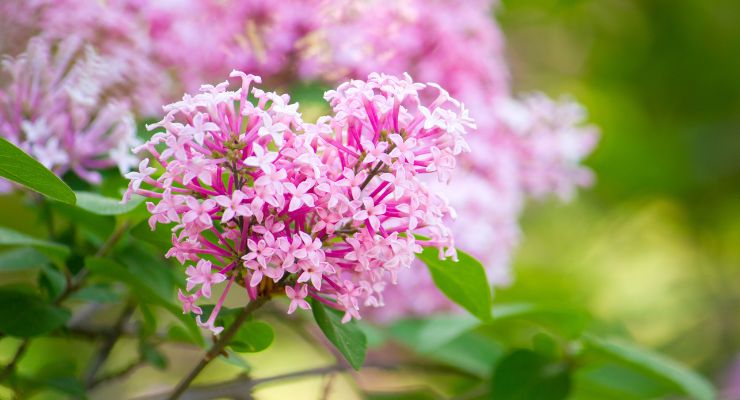
Peony (Peony Suffruticosa)
The tree peony, scientifically known as Peony suffruticosa, is a deciduous woody shrub with a typical height of 3-5′ and a spread of 4′. This plant produces numerous semi-double blooms that range from 6-8″ in mid to late spring. The plant’s open habit, thick twigs, and woody stems do not die back during winter.
To keep the Paeonia suffruticosa healthy, plant it in a spot that has excellent soil drainage and receives ample sunlight or light shade. It thrives in zones 4-9 and should be planted deeply. Tree peonies require some dappled shade to protect their fragrant flowers from the hot afternoon sun. It is best to plant them in areas that are shielded from drying winds during summer and winter. Once established, the plant is highly drought-tolerant. For optimal growth, tree peonies require a cold winter for dormancy and hot summers.
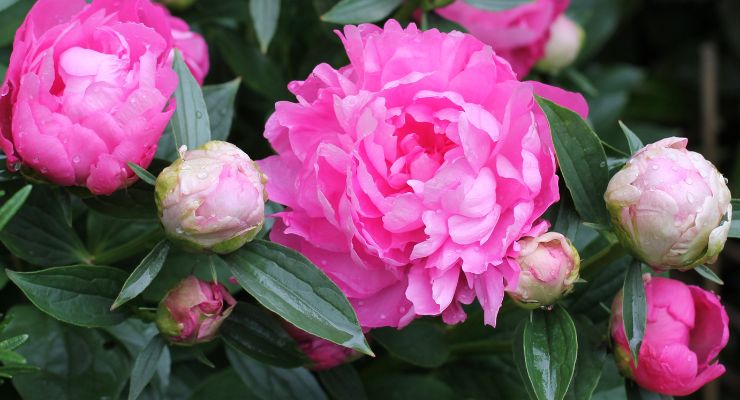
Bougainvillea (Bougainvillea)
Bougainvillea is a thorny ornamental plant that can be found in the form of vines, bushes, and trees. It prefers dry conditions and well-drained soil in full sun. To encourage bushier growth, it is recommended to pinch off the soft, growing tips of young stems. However, overwatering should be avoided as it can lead to root rot and fungal diseases. Bougainvillea blooms better when kept on the dry side.
The leaves of Bougainvillea are large and ovate with rippling along the edges and hairs on the underside. The plant has a dense and chaotic growth habit, with long, trailing stems covered in sharp spines. The colorful bracts appear up and down the branches in shades of red, dark pink, or purple, while the small flowers are cream-colored. Bougainvillea produces small dry fruits known as achenes with a single seed and bears grooves or wings; the persistent perianth tube, which may be fleshy, often surrounds it.

Curly Leaf Spirea (Spiraea Japonica)
The curly leaf spirea, also known as Spiraea japonica, is a deciduous shrub that grows up to 6 feet tall and wide with small pink flowers and wavy leaves. To promote flower production and prevent scraggly growth, it is important to prune the plant on a 1-3 year cycle and avoid overwatering. Prune it after the light pink flowers have faded, typically in the spring, as most Spiraea shrubs bloom during that time
This Japanese spirea has a compact habit, large clusters of white or pink flowers in late spring and summer, and beautiful golden yellow fall color, providing multiple seasons of enjoyment. When selecting companion plants for spirea, it’s essential to consider their growing conditions and choose plants that can tolerate similar conditions. For example, Goldmound spirea, a rounded deciduous shrub with golden yellow foliage, pairs well with other plants that can thrive in dry conditions.
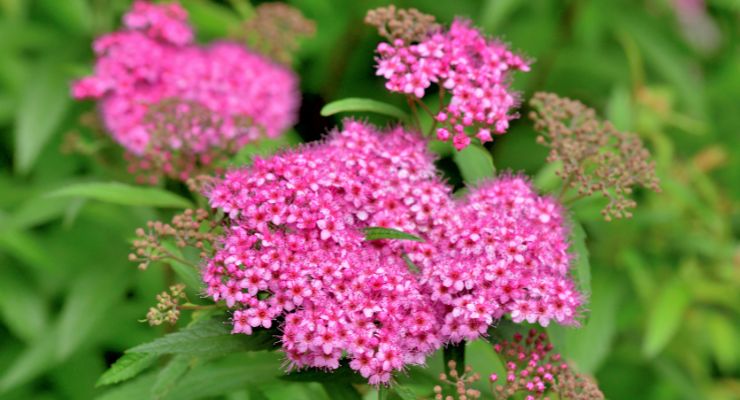
Sonic Bloom Weigela Shrub (Weigela Florida ‘BOKrasopin’)
The Sonic Bloom Weigela shrub, scientifically known as Weigela florida ‘Bokrasopin’, is a reblooming shrub that bears striking trumpet-shaped pink flowers from late spring through mid-fall. With its attractive glossy green foliage, the plant grows into a majestic mounded shrub that spans 4-5 feet in width and is known to attract hummingbirds while deterring deer.
Proper care for the Sonic Bloom Weigela shrub involves planting it in well-drained soil, and ensuring it receives at least six hours of full sun per day. In warmer regions, some partial shade is recommended. Maintenance of Weigela bushes is hassle-free, and pruning is best done right after the plant finishes flowering to avoid cutting off next year’s pink blooms. While drought-tolerant once established, the shrub benefits from regular watering during extended dry periods.

Butterfly Bush (Buddleja Davidii)
The butterfly bush (Buddleja davidii) is a deciduous shrub that can reach up to 15 feet in height with arching branches. Its jagged-edged leaves are opposite-growing and measure 5-10 inches in length. The plant blooms from mid-summer to early fall, producing drooping or upright spikes of lovely pink flowers at the end of its branches. The butterfly bush is a fast-growing, drought-tolerant shrub that thrives in full sun and well-drained soil.
When planting multiple butterfly bushes, it is important to space them apart to promote good air circulation and prevent disease spread. Butterfly bushes are recommended for USDA hardiness Zones 5 to 10, and planting them in an ideal location minimizes maintenance time.
To attract butterflies, plant butterfly bushes where they can be easily viewed and with other fall-blooming butterfly attractors like an aster. Some dwarf varieties of butterfly bush can be grown successfully in containers. When selecting companion plants for butterfly bushes, it is crucial to consider the growing conditions and choose plants that can tolerate similar conditions, such as Verbena bonariensis, pineapple sage, purple salvia, lantana, swamp milkweed, asters, and more.

Pink Forsythia (Abeliophyllum Distichum)
Pink forsythia, or Abeliophyllum distichum roseum, that is also known as Korean abelia, is a deciduous shrub that blooms in spring with white to lightly pink-tinted, 4-petaled flowers that open from purple buds. Growing up to 6 feet tall and wide with a round habit and multiple stems.
To grow pink forsythia, plant it in well-drained soil in full sun to part shade and fertilize once in early spring with 10-10-10 to enhance the next year’s crop of pink flowers once the plants are established. However, fungal twig blights and knobby galls forming along the stems are common issues that gardeners may face while growing pink forsythia.
Improper pruning is the most common reason for pink forsythia not blooming, as pink blooms are produced on one-year-old wood. To avoid removing the buds that would have produced deep pink flowers, pruning should be done after the plant has bloomed.
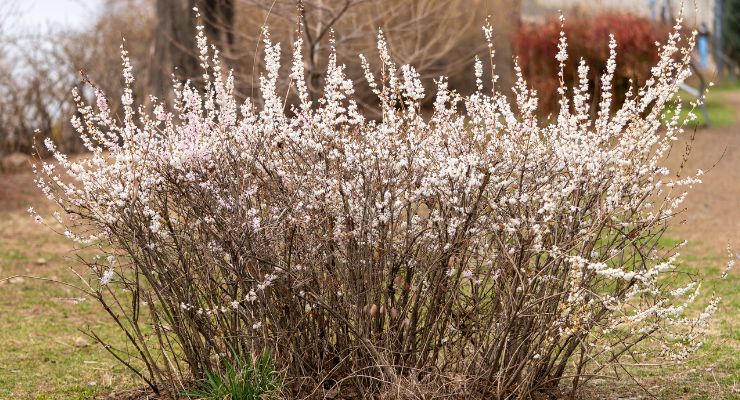
February Daphne (Daphne Mezereon)
February daphne (Daphne mezereum) is a small upright shrub that can grow up to 3-5 feet in height and width. The plant has soft, spirally arranged leaves and produces bright purple-pink blooms in February and March in its native European range. It also bears a poisonous bright red berry as fruit, and all parts of the plant can be harmful to humans. Handle the plant with care to avoid skin irritation or ingestion.
To care for February daphne, plant it in a partially shady to full shade location with protection from the wind. Full sun can cause leaf scorching. The plant prefers moist, organically rich, sandy alkaline soils and is hardy to zone 4. Water it regularly during dry spells and fertilize it with a balanced fertilizer once in early spring. Prune after flowering to maintain its shape and remove any dead or damaged wood.
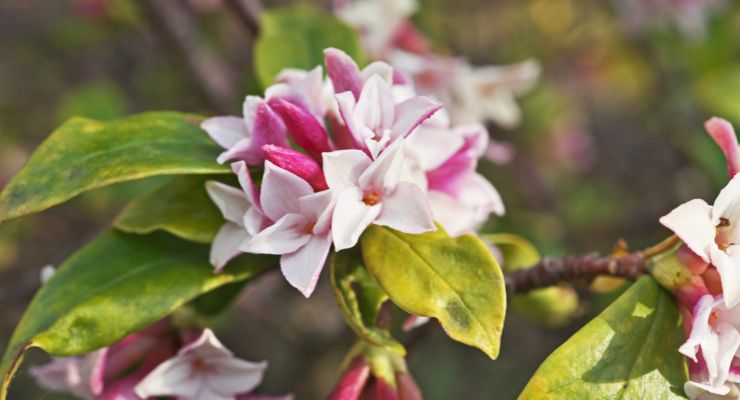
Japanese Quince (Chaenomeles japonica)
Japanese quince (Chaenomeles japonica) is a deciduous shrub with tangled gray-brown twigs and abundant clusters of bright orange-scarlet flowers that can reach up to 1.5 inches across. This plant is native to Japan and is a low-maintenance shrub that prefers full sun to partial shade and well-drained soil. Japanese quince can tolerate drought once established but prefers regular watering during dry spells. To maintain its shape and remove any dead or damaged wood, prune it after flowering.
Although the Japanese flowering quince is a showy and low maintenance shrub, it is not as widely available commercially as other flowering shrubs because it is not as ornamental. Nonetheless, it can be paired with a variety of companion plants. Some recommended companion plants for Japanese quince include Oriental fountain grass, hellebores, and flowering almond. Forsythia is also a good companion plant for flowering quince because the golden blooms arrive at just about the same time as the quince flowers. Other shrub and tree companions for Japanese quince include spirea, mock orange, pyracantha, and abelia.
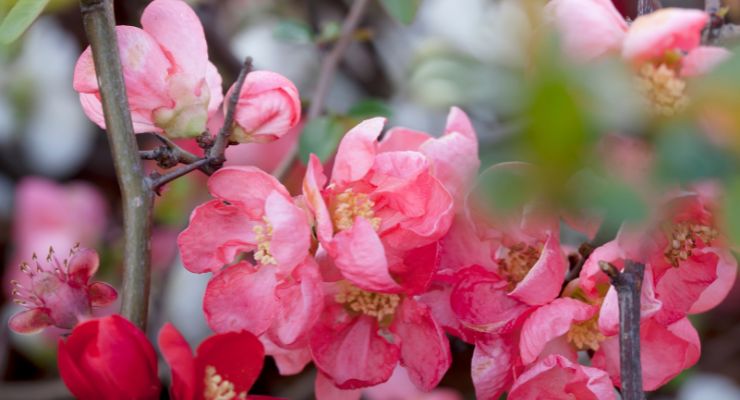
Pink Abelia (Abelia cv. Edward Goucher)
Pink Abelia (Abelia x ‘Edward Goucher’) is a cold-resistant, semi-evergreen shrub that adds beauty to any garden. Its gracefully arching branches can grow up to 6 feet tall and wide, and it produces small, bell-shaped, lilac, pink flowers from mid-summer to fall. The plant is low maintenance and requires little pruning, but you can prune it after flowering to maintain its shape. Pink Abelia prefers full sun to part shade and acidic, well-drained soil. In the fall, its leaves turn bronze, making it a beautiful addition to any garden border or mass planting. To give your Pink Abelia the best chance to thrive, plant it in early spring, early summer, or when temperatures are mild so that it can establish its roots before the hot summer months.
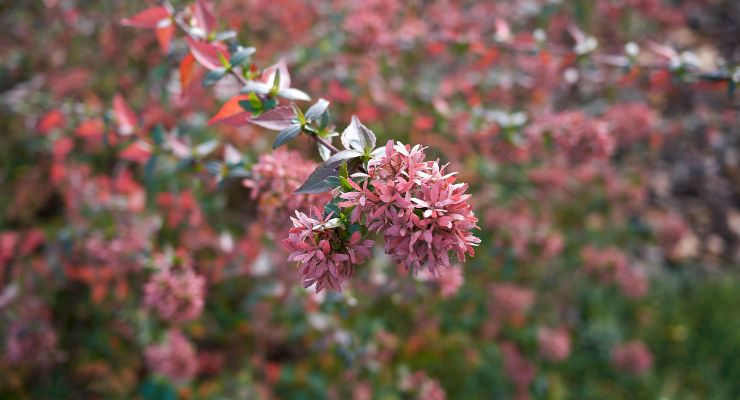
Cherry Cheesecake Rhododendron (Rhododendron x ‘Cherry Cheesecake’)
Cherry Cheesecake Rhododendron (Rhododendron x ‘Cherry Cheesecake’) is a stunning, evergreen shrub with a compact, mounding form that can reach 4 to 5 feet in both height and width. It is adorned with showy, multi-colored flowers in late spring, featuring white ruffled petals with hot pink edges and deep red smudges on the upper lobes, growing in large trusses. Unlike other rhododendrons, it has thicker stems and leaves that provide a strong, year-round structure and can survive in zone 5. The plant’s pink and white flowers last longer, making it an exceptional addition to any garden or landscape design.
For proper care of Cherry Cheesecake Rhododendron, plant it in a partially sunny location with afternoon shade. The plant prefers organically rich, well-draining, slightly acidic soil. Avoid planting it in an area with a crown, and apply a thick layer of mulch around the roots to keep them cool. Water newly planted shrubs more frequently than established ones.
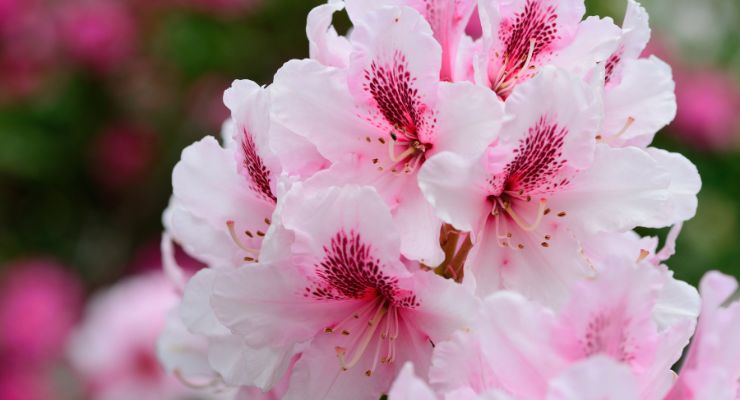
Oleander ‘Hardy Pink’ (Nerium oleander)
Oleander ‘Hardy Pink’ is a deer and salt-tolerant intermediate-growing shrub that can reach 6-8 feet tall in the landscape, but in mild climates, it may grow even larger. The plant features soft, rose-pink flowers and is bred to be hardier than other oleanders in colder temperatures. It prefers full sun and well-drained soils with medium moisture levels. In addition to being heat, drought, wind, air pollution, and poor soil tolerant, Oleander ‘Hardy Pink’ also works well in coastal gardens due to its salt tolerance.
The best times to plant Oleander ‘Hardy Pink’ are early spring before the growth spurt or late summer to early autumn after the blooming period.
Companion plants that pair well with Oleander ‘Hardy Pink’ include astilbe, mountain laurel, mahonia, pieris, and viburnum. Dianthus is also a great companion plant for oleanders, as it not only offers a beautiful contrast but also helps keep away unwanted insects and pests.

Yuki Cherry Blossom (Deutzia)
Yuki Cherry Blossom Deutzia is a deciduous shrub with cup-shaped pink flowers that appear in stunning racemes with white tips on the ends of its branches. Its flowers are similar in appearance to showy cherry blossoms, hence its common name. The shrub has dark green, serrated, ovate leaves that can grow up to 3 inches long. Yuki Cherry Blossom Deutzia blooms on old wood and needs to be watered when the top 2 inches of soil become dry. The plant has a mounded shape and should be planted 1-2 feet apart.
To care for Deutzia, plant it in full sun for the best flowering results and average, well-drained garden soil. While it prefers moist, rich, humusy loams, it can tolerate a wide range of soil types. Once established, it can tolerate some drought. Water the shrub well after planting and regularly thereafter. In the spring, fertilize the plant. Pruning is not required, but trimming back stems every few years can make the plant bushier. It’s essential to prune immediately after flowering since the flower buds are formed on old wood, and pruning at other times may remove the pink flowers for the next year.
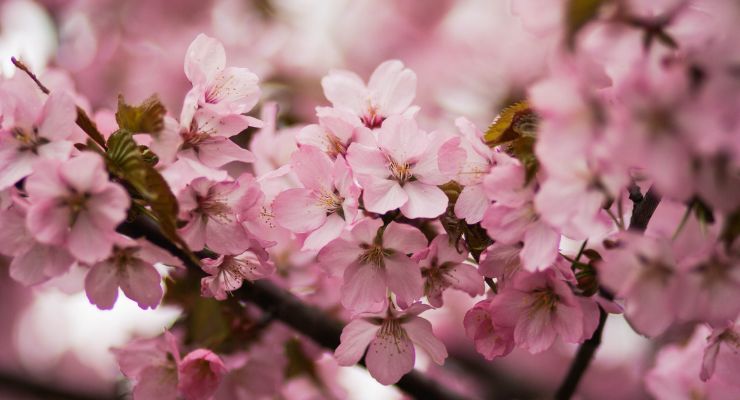
Rose of Sharon (Hibiscus syriacus)
The Rose of Sharon is a deciduous plant that can grow as a shrub or small tree with several trunks, and it has an upright or sometimes spreading growth habit. The plant blooms in the summer, which is a rare time for shrubs to bloom, making it a desirable addition to any garden or landscape. For more information on the characteristics and care of Rose of Sharon, please refer to our previous article.
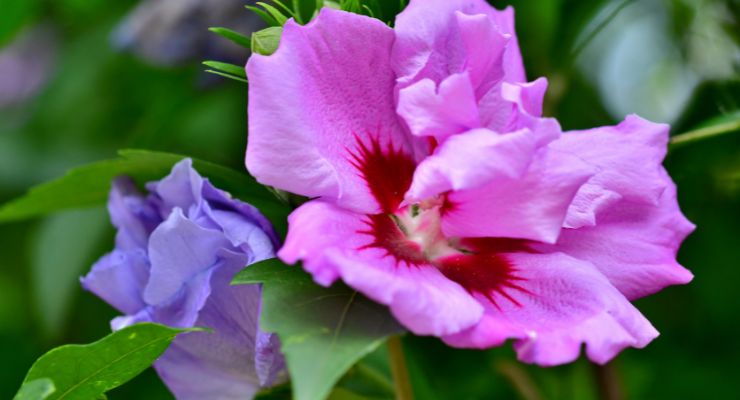
Conclusion of Pink Flowering Shrubs
Shrubs with pink flowers can add beauty and color to any landscape. They are available in a wide variety of sizes, shapes, and bloom times, making them a versatile choice for many different settings. From delicate pink roses to bold fuchsia hydrangeas, there is a pink flowering shrub that will suit any style and taste.
It’s important to choose the right pink flowering shrub for the location and purpose you have in mind. Ensure that the shrub you choose is suited to the climate in your area. Choose a shrub that will thrive in the soil type you have in your garden. Consider how much sun the area receives throughout the day and choose a shrub that will thrive in those conditions.
Consider why you are adding the shrub to your landscape. Are you looking for privacy, shade, or simply adding color and beauty to your garden?
In summary, pink flowering shrubs can be a beautiful and valuable addition to any landscape. By selecting the right shrub for the right location and purpose, you can ensure that your garden will be a vibrant and inviting space that is both functional and aesthetically pleasing.
